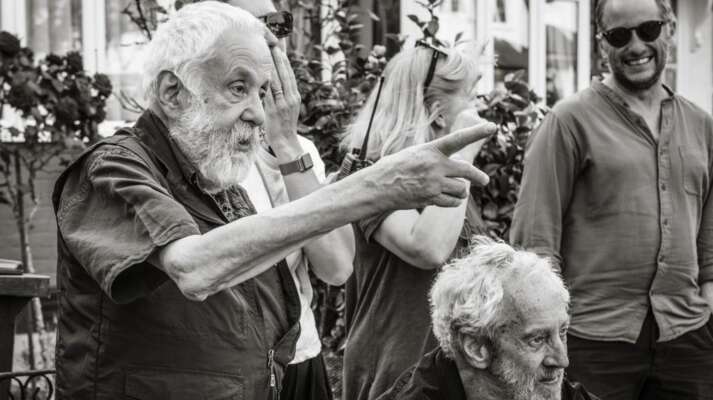New Horizons
Films of Women Reinventing Their Lives
New Horizons
Written by Peter Bowen
THE LAST WORD | Rewriting The Story Of Your Life
In Mark Pellington’s THE LAST WORD, Shirley MacLaine plays Harriet Lauler, a woman approaching her golden years who wants to shine up her reputation a bit. She has lived most of her life on her own terms, a practice that has garnered her much success, but few friends. When she hires a local writer, Anne Sherman (Amanda Seyfried), to pen an obituary she can approve of while she’s still alive, she unfortunately discovers how poorly her supposed friends and family think of her. Determined to rewrite her own story to reach a happier ending, she embarks on a journey of rediscovering who she really is and how to express that. This gesture of self-empowerment proves infectious, as Anne and Brenda (Ann’Jewel Lee), the 9-year-old girl Harriet has agreed to mentor, choose to chart new destinies for themselves as well. THE LAST WORD is “a movie about how each generation can influence the next,” explains screenwriter Stuart Ross Fink. “It’s funny. It’s emotional. It is about the lives we lead and the legacies we hope to leave behind, which people of all ages…can relate to.” To celebrate our ability to change at any age, we showcase a series of stirring films whose characters discover new horizons for themselves.
Baby Boom | Becoming the Mother of Invention

Shirley Valentine | Giving Yourself Leave To Change
 Shirley Valentine, Lewis Gilbert’s postcard adventure about how a English housewife (Pauline Collins) trades in her drab existence for a sunny beach in Greece, not only became a surprise hit when it was released in 1989, but has gone on to be an enduring fable about reinventing one’s life. The film adaptation opens up Willy Russell’s 1986 one-character play to show both her dead-end life frying up eggs and chips for her emotionally distant husband in Liverpool and the sunny Greek islands to which she escapes. The film’s Agios Ioannis location in Mykonos, Greece was so striking that it is now often referred to as the “Shirley Valentine” beach in tourist brochures. Like the character that made her famous, Collins’s life also changed abruptly in middle age. “I always figured 45 would be the start of my stardom,” she joked to New York Magazine. Previously Collins had been relegated to mostly supporting roles on TV, like her ongoing role as the maid Sarah in the 70s series Upstairs, Downstairs. But her sparkling performance as Valentine opened up people’s eyes not only to her talent, but also to what her character represents. “In the end, you will cheer Shirley Valentine as she learns to love just being herself,” exclaims Spirituality & Practice’s Frederic and Mary Ann Brussat. For many women, Shirley Valentine’s audacious decision to turn her back on the past provides a how-to manual on changing one’s life. The Washington Post’s Joe Brown found the “uncommonly warm, relaxed little movie… a comically updated A Doll's House––only, instead of slamming the door, our newly liberated heroine hangs up the phone.” The film was nominated for two Academy Awards, including a Best Actress nod for Collins. Collins continues to work in film and TV. But, following the example set by her famous character, Collins turned down roles that seemed too similar to Valentine. The character, however, has never gone out of fashion. The original play continues to be staged around the world, and this year it is set for a major revival in London to celebrate its 30th anniversary.
Shirley Valentine, Lewis Gilbert’s postcard adventure about how a English housewife (Pauline Collins) trades in her drab existence for a sunny beach in Greece, not only became a surprise hit when it was released in 1989, but has gone on to be an enduring fable about reinventing one’s life. The film adaptation opens up Willy Russell’s 1986 one-character play to show both her dead-end life frying up eggs and chips for her emotionally distant husband in Liverpool and the sunny Greek islands to which she escapes. The film’s Agios Ioannis location in Mykonos, Greece was so striking that it is now often referred to as the “Shirley Valentine” beach in tourist brochures. Like the character that made her famous, Collins’s life also changed abruptly in middle age. “I always figured 45 would be the start of my stardom,” she joked to New York Magazine. Previously Collins had been relegated to mostly supporting roles on TV, like her ongoing role as the maid Sarah in the 70s series Upstairs, Downstairs. But her sparkling performance as Valentine opened up people’s eyes not only to her talent, but also to what her character represents. “In the end, you will cheer Shirley Valentine as she learns to love just being herself,” exclaims Spirituality & Practice’s Frederic and Mary Ann Brussat. For many women, Shirley Valentine’s audacious decision to turn her back on the past provides a how-to manual on changing one’s life. The Washington Post’s Joe Brown found the “uncommonly warm, relaxed little movie… a comically updated A Doll's House––only, instead of slamming the door, our newly liberated heroine hangs up the phone.” The film was nominated for two Academy Awards, including a Best Actress nod for Collins. Collins continues to work in film and TV. But, following the example set by her famous character, Collins turned down roles that seemed too similar to Valentine. The character, however, has never gone out of fashion. The original play continues to be staged around the world, and this year it is set for a major revival in London to celebrate its 30th anniversary.

Fried Green Tomatoes | Learning from Those Who Came Before
When Jon Avnet was given Fannie Flagg’s 1987 novel Fried Green Tomatoes at the Whistle Stop Café for a possible film adaptation, he fell in love with its sprawling world of resilient Southern women. He spent the next four years developing the film, even taking over writing the screenplay when the first two drafts didn’t meet his expectations. To handle the novel’s shifting time periods, Avnet grounds his story in contemporary Alabama with Ninny Threadgoode (Jessica Tandy), a smart and sassy resident at a nursing home, befriending a depressed middle-age woman, Evelyn Couch (Kathy Bates). The elderly Ninny regales her new friend with tales about life in her hometown, Whistle Stop, Alabama, fifty years before. At the start of the Great Depression, Ninny’s sister-in-law, Idgie (Mary Stuart Masterson) opened up the Whistle Stop Cafe. It soon becomes a sanctuary for those displaced by the society around them, including Idgie’s best friend, Ruth (Mary-Louise Parker), and her young child who are fleeing an abusive marriage. The inspiration for the story came from Flagg’s great aunt, Bess Fortenberry, who opened a similar place, the Irondale Café, in 1932. Her great-aunt also provided a personal example for Flagg about how to realize one’s dreams by facing down one’s fears. "From the time I was six years old…I longed to be a writer, always wanted to be a writer," Flagg explains to Americana. But dyslexia kept her trying till she was middle-aged. Much like the characters in her novel, Flagg drew strength from the strong women who preceded her. In the novel, the henpecked Evelyn finds the courage to change from Ninny. “Evelyn is so fired up by Idgie's escapades, she begins to take control of her life,” observes Washington Post’s Rita Kempley. “She gives up her candy bars for aerobics, stops trying to please her lug nut of a husband and begins a career as a cosmetics saleswoman.” In many ways, Evelyn speaks for the author and the other characters when she explains to her husband how she turned her life around: “Do you know what I did about it?...I changed."
Julie & Julia | A Recipe for Change

The Best Exotic Marigold Hotel | The Inn Crowd



